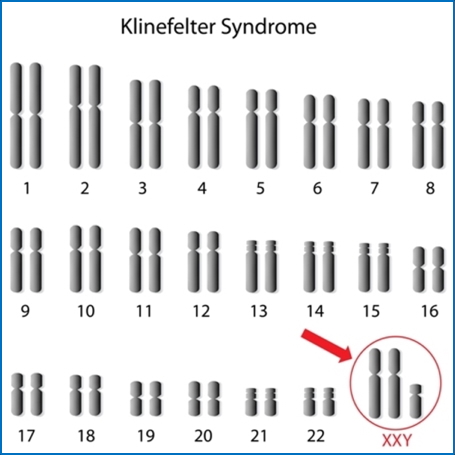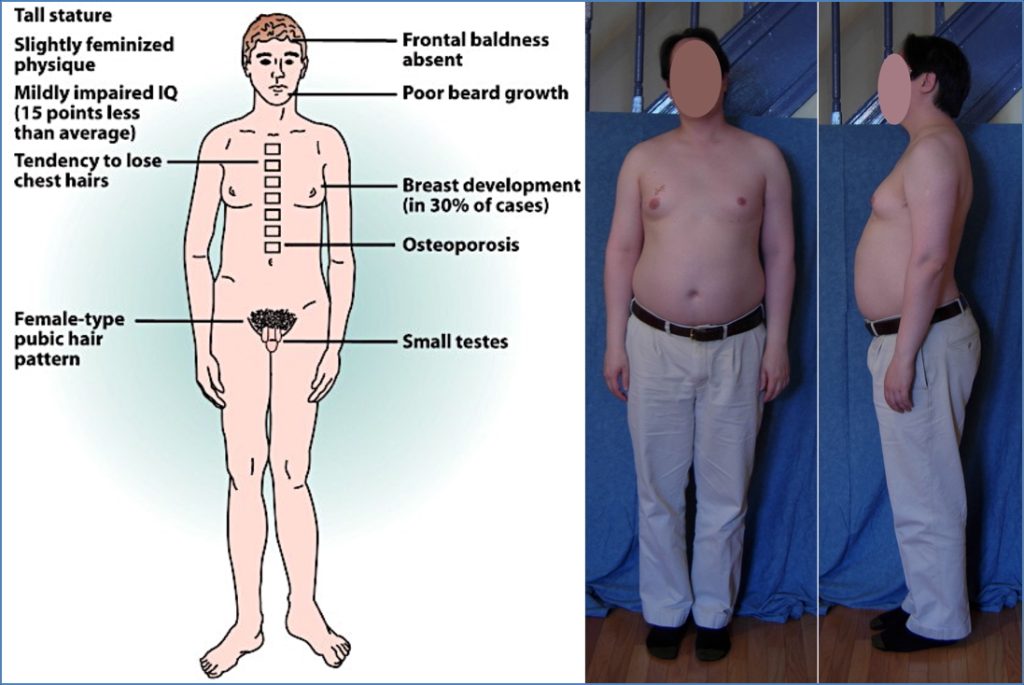Table of Contents
Overview – Klinefelter’s Syndrome
Klinefelter’s syndrome is a genetic condition affecting biological males who are born with an extra X chromosome (47, XXY). This chromosomal variation disrupts normal testicular development, leading to reduced testosterone levels and impaired male secondary sexual characteristics. While symptoms can be subtle during childhood, many cases remain undiagnosed until adolescence or adulthood.
Definition
Klinefelter’s syndrome is a chromosomal disorder where a male is born with one or more extra X chromosomes. The most common karyotype is 47, XXY. This condition results in hypogonadism, infertility, and variable developmental and cognitive challenges.
Aetiology
- Cause:
- Nondisjunction of sex chromosomes during meiosis leads to an extra X chromosome in a male (47, XXY)
- Epidemiology:
- Occurs in approximately 1 in 600 live male births
- Risk Factors:
- Increasing maternal age is weakly associated with increased risk

Morphology / Pathophysiology
- Small, firm testes due to seminiferous tubule dysgenesis
- Decreased testosterone production → impaired virilisation
- Gonadotropin levels (FSH and LH) are elevated due to feedback failure
- Azoospermia is common due to germ cell degeneration
- Increased risk of breast cancer and osteoporosis due to oestrogen excess/testosterone deficiency
Clinical Features
- Often asymptomatic in early childhood
- Diagnosis frequently delayed until puberty or adulthood
- Common features include:
- Small testes and hypogonadism
- Gynaecomastia (breast tissue development)
- Reduced facial, pubic, and body hair
- Reduced muscle mass and strength
- Tall stature with disproportionately long legs and shorter torso
- Infertility due to azoospermia
- Delayed or incomplete puberty
- Mild learning difficulties and language-based cognitive impairment
- Emotional immaturity or shyness in some cases

Investigations
- Hormonal Tests:
- ↓ Testosterone
- ↑ Luteinising hormone (LH)
- ↑ Follicle-stimulating hormone (FSH)
- Genetic Testing:
- Chromosomal karyotype confirms 47, XXY
- Semen analysis:
- Typically reveals azoospermia
Management
- Endocrine Therapy:
- Lifelong testosterone replacement therapy (improves muscle mass, bone density, energy, and libido)
- Surgical Management:
- Mastectomy for significant gynaecomastia
- Supportive Therapy:
- Speech and language therapy
- Physiotherapy
- Educational support for learning difficulties
- Psychological counselling and social support
Complications
- Infertility (most common and significant long-term issue)
- Increased risk of:
- Breast cancer
- Osteoporosis
- Metabolic syndrome
- Type 2 diabetes
- Depression and anxiety
Differential Diagnosis
- Constitutional delay of puberty
- Androgen insensitivity syndrome
- Other causes of primary hypogonadism (e.g. mumps orchitis, testicular trauma)
- Turner’s syndrome (in females) – helpful for contrasting chromosomal presentations
Summary – Klinefelter’s Syndrome
Klinefelter’s syndrome (47, XXY) is a common chromosomal condition in males, characterised by hypogonadism, infertility, tall stature, and reduced masculine features. Early diagnosis and testosterone therapy can significantly improve quality of life and reduce complications. For more information, explore our Genetics & Cancer Overview page.